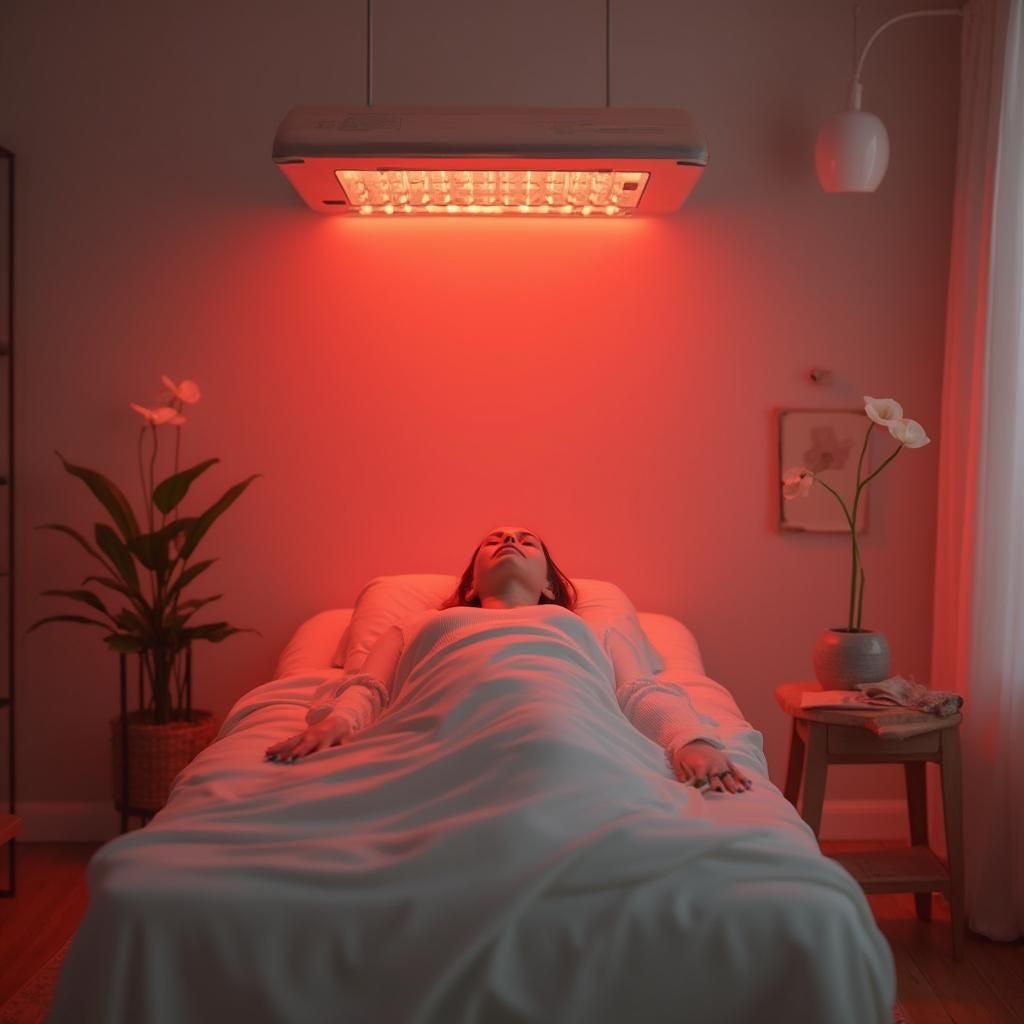Ever stared at your ceiling can light and wondered, “Can this give me glowing skin?”
Short answer: Nope! For real results, you’ll need proper tools like Red Light Therapy Panels, Red Light Therapy Beds, or Red Light Therapy devices. Read on to find out why your light fixture just won’t cut it.

What is Red Light Therapy? (And How Does it Work?)
Understanding Red Light Therapy (RLT): Definition and Common Terms
What is RLT? (Brief definition and explanation)
Red light therapy (RLT) is a non-invasive treatment that uses low-level red and near-infrared light to support healing and boost skin health. It's commonly used to reduce pain, inflammation, and signs of ageing.
This therapy can be done at clinics or with red light therapy at home devices, depending on your needs.
Other names for RLT
RLT is also known as:
-
Low-level light therapy (LLLT)
-
Photobiomodulation
-
Cold laser therapy
These terms all refer to light-based treatments that encourage cellular repair and regeneration.
The Science Behind Red Light Therapy: How it Works at a Cellular Level

Role of Mitochondria in RLT
When light penetrates the skin, it targets the mitochondria, often called the powerhouse of the cell.
This boosts the production of adenosine triphosphate (ATP), giving your cells more energy to function and repair themselves.
Wavelengths and Penetration
The key to effective treatment lies in the wavelength.
-
Red light (630–660nm) affects the skin’s surface.
-
Near-infrared light (810–850nm) reaches deeper tissues.
Both fall within the therapeutic window, crucial for triggering benefits.
Key cellular benefits
Some of the core benefits include:
-
Increased collagen production
-
More active fibroblasts
-
Enhanced circulation
-
Decreased inflammation
These changes help improve skin health, tissue recovery, and overall vitality.
Red Light Therapy Benefits: What Can It Help With?
Skincare and Anti-Aging Benefits of Red Light Therapy
Addressing wrinkles, fine lines, and age spots
By stimulating collagen and elastin, red light therapy helps reduce the appearance of wrinkles and age spots, leaving skin looking younger.
Improving skin texture and complexion
It supports cell turnover and circulation, which can brighten skin tone and improve texture.
People often report smoother, clearer skin with consistent use.
Treating acne, psoriasis, rosacea, and eczema
RLT can reduce inflammation and calm flare-ups in various skin conditions, from acne to eczema.
Reducing scars and stretch marks
With time, red light therapy may help soften scar tissue and make stretch marks less visible by encouraging skin renewal.
Aiding in wound healing and tissue repair
Red light has been shown to speed up healing of minor cuts, burns, and abrasions.
It does this by stimulating tissue growth and reducing inflammation.
Combating sun-damaged skin
It may help repair UV-damaged skin, improving tone, reducing redness, and fading discolouration caused by sun exposure.
Other Potential Health Applications of Red Light Therapy
Hair growth (androgenic alopecia)
RLT may stimulate dormant hair follicles and support hair regrowth, especially in cases of pattern baldness.
Muscle recovery and pain relief
Red light therapy can reduce muscle soreness and support joint health, making it popular among athletes and those with chronic pain.
Sleep improvement
Exposure to red light before bed can aid melatonin production, helping to balance your circadian rhythm and improve sleep.
Side effects of cancer treatments
In medical settings, RLT is sometimes used to manage treatment side effects like oral mucositis or radiation dermatitis.
Considerations Before Trying Red Light Therapy

Safety, Side Effects, and Risks of Red Light Therapy
General safety and non-invasiveness
Red light therapy is generally safe, painless, and suitable for most skin types when used properly. It’s non-invasive and has minimal downtime.
Potential risks
Risks are low but may include mild skin irritation or burns if the device is faulty or overused. Always follow usage guidelines and ensure proper quality control.
Choosing a Red Light Therapy Device (At-Home vs. Professional)
Factors to consider when buying
Look for devices with:
-
Wavelengths between 630–850nm
-
CE or FDA clearance
-
Multiple LEDs
-
Strong power output
Choosing the right device ensures better results and safer use.
Types of devices
You’ll find different options, such as:
-
Face masks for targeted skin treatment
-
Handheld wands for spot care
-
Red Light Therapy Panels for larger areas
-
Red Light Therapy Beds for full-body therapy
Your choice depends on your goals, space, and budget.
Importance of consistent use and expected results
Results build up over time. Regular sessions—just 10–20 minutes a few times a week—can lead to noticeable improvements in 4–8 weeks.
Consulting a Healthcare Professional (When to seek medical advice)
Confirming diagnosis and discussing appropriate treatment options
If you’re considering RLT for health concerns like psoriasis, arthritis, or hair loss, it's best to speak with your GP or dermatologist. They can help ensure it’s appropriate and safe.
Final Takeaways
-
Can lights don’t work for red light therapy—they lack the right wavelength and power.
-
Use dedicated Red Light Therapy Panels, masks, or beds for proper results.
-
Red Light Therapy at Home is convenient and effective, if done with the right equipment.
-
Stick with a consistent routine and check device specs for safety and efficacy.
-
Always consult a professional if using RLT for medical conditions.






